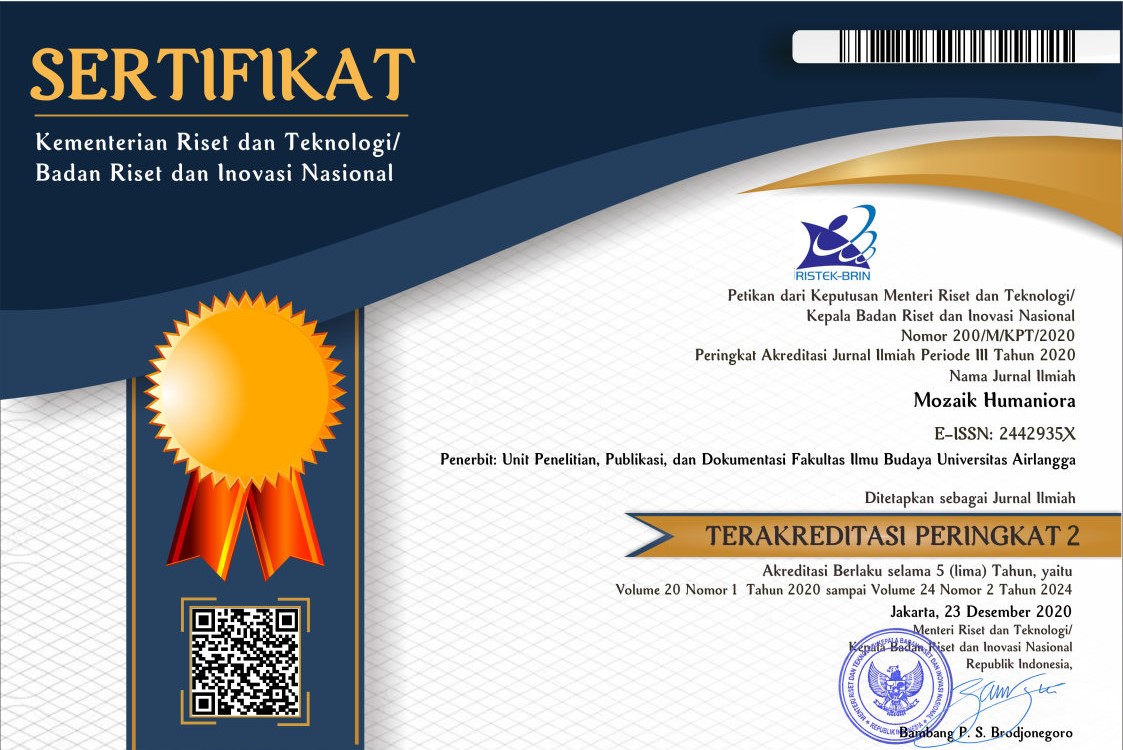THE MOUSEDEER: THE SIMBOL OF LOWER CLASS' RESISTANCE AGAINTS THE RULING GROUP
Downloads
This studi aims to reveal the constructed values in the story of the mousedeer through a social class approach. This study analyzes three types of the mousedeer stories considered to contain any social symbols that could lead to the representation of certain social groups. This study is based on Stuart Hall's theory of Representation and Karl Marx's theory of Social Class. The result of the analysis shows that the mousedeer stories contain the representation of class structures as there occured in people's social relations. The stories contain conflict between social classes or class struggle caused by inequality in the ownership of power, where there are the opposing parties acting as the owner of this power and the mousedeer as the representation of parties without power. Here, the mousedeer who always be able to get away by tricking his strong opponents is a symbol of resistance against them, the onces who owns the power, the authority. These mousedeer stories also has a potential to indicate the psychological turmoil or expression of the lower society who tries to oppose the ruling repression in their era.
Canonici. N, N. (1995). Tricksters and Trickery in Zulu Folktales. University of Natal, Durban.
Carpenter, K. (2006). Kancil: From Mischief to Moral Education. Western Folklore. https://doi.org/10.2307/1499360.
Denzin. N. K, & Lincoln. Y. S, (2009). Handbook of Qualitative Reserach. Pustaka Pelajar. Yogyakarta.
Hall. S, (1997) Representation:Cultural Representations and Signifying Practices. California: SAGE Publictions.
Jaisa-Ard, S. (2008). The Antagonist in the Trickster Tale of Trang Quynh. Journal of Humanities, Special Issue no.15, 2008.
Mallinson, C. (2007). Social Class, Social Status and Stratification: Revisiting Familiar Concepts in Sociolinguistics (Vol. 13). Retrieved from http://repository.upenn.edu/pwpl/vol13/iss2/12.
McKean, P. F. (2006). The Mouse-deer ("Kantjil”) in Malayo-Indonesian Folklore: Alternative Analyses and the Significance of a Trickster Figure in South-East Asia. Asian Folklore Studies. https://doi.org/10.2307/1177765.
Purnomo. H, (2013) Kumpulan Cerita Rakyat Nusantara. Tugu Publisher. Yogyakarta.
Suryanto, E., & Waluyo, B. (2017). Pembelajaran Apresiasi Cerita Rakyat Bermedia Wayang Kancil. Journal Indonesia Language Education and Literature, vol.3 no.1. https://doi.org/10.24235/ileal.v3i1.1700.
Smith, A. (2005). Blues, Criticism, and the Signifying Trickster. Popular Music, Vol.24, No. https://doi.org/10.1017/S0261143005000449.

Mozaik Humaniora is licensed under a Creative Commons Attribution-ShareAlike 4.0 International License. Both authors and Mozaik Humaniora agree with the following attribution of journal:
1. Copyright of this journal is possession of Author, by the knowledge of the Editorial Board and Journal Manager, while the moral right of the publication belongs to the author.
2. The journal allows the author(s) to retain publishing rights without restrictions
3. The legal formal aspect of journal publication accessibility refers to Creative Commons Attribution Share-Alike (CC BY-SA).
4. The Creative Commons Attribution Share-Alike (CC BY-SA) license allows re-distribution and re-use of a licensed work on the conditions that the creator is appropriately credited and that any derivative work is made available under "the same, similar or a compatible license”. Other than the conditions mentioned above, the editorial board is not responsible for copyright violation.


















